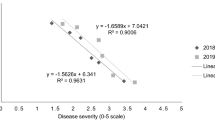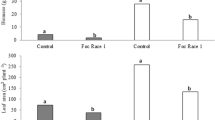Summary
Four different species and strains ofFusarium, namely,F. oxysporum f.vasinfectum (Atk.)Snyder &Hansen,F. solani (Mart.)App. &Wr.,F. vasinfectum (Atk.) f1 Wr. strainFahmy, andF. vasinfectum Atk. are responsible for cotton wilt in U.A.R. Pathogenicity experiments have shown that the four experimentalFusaria possess varying degrees of pathogenicity towards two susceptible cotton varieties, namely, “Karnak” and “Bahtim 190”. On the other hand, “Ashmouni” cotton proved resistant to the fourFusaria. Variability of pathogenicity of the experimentalFusaria is not only related to host cotton plant or parasite, but also to nitrogenous fertilizer or manurial treatment of the soil. Resistance of “Ashmouni” cotton was not broken in presence of sodium nitrate, ammonium nitrate or stable manure added to soil inoculated with any of the fourFusaria. The application of nitrogen fertilizers or manure resulted on the whole, in increased wilt-disease incidence of the susceptible cotton varieties. Stable manure enhanced predisposition to vascular-wilt more than other nitrogen treatments, especially in presence of the virulentF. oxysporum f.vasinfectum or both strains ofF. vasinfectum Atk. Ammonium nitrate induced the sudden appearance of mottling characteristic of vascular-wilt of cotton when “Bahtim 190” plants were raised in nitrogen-fertilized soil inoculated withF. solani (Mart.)App. &Wr. At the same time, the raised affected plants showed increased growth-vigour and enhanced maturity of their leaves.
Similar content being viewed by others
References
Antoinette, A. H. 1965. The nutritional requirements of cotton in relation toFusarium wilt; M. Sc. Thesis, A'in Shams Univ., Fac. Sci. Cairo, 201 pp.
Armstrong, G. M. &Albert, W. B. 1941. Cotton nutrition in relation toFusarium wilt; Proc. Ass. Southern Afr. Workers42 198.
Bakri, M. A., Sakr, A. H., Kassab, O. A. &Rizk, R. H. 1958. Infection of some cotton varieties withFusarium and the possibility of the existence of strains of this fungus; Proc. 2nd Cotton Cong., Cairo (in Arabic).
Fahmy, T. 1928. TheFusarium disease of cotton (wilt) and its control; Bull. Egypt. Min. Agric.74.
Fikry, A, 1932. Investigations on the wilt disease of Egyptian cotton caused by various species ofFusarium; Techn. Sci. Serv. Min. Agric. Egypt119.
Lilly, V. G. &Barnett, H. L. 1951. Physiology of the fungi; 1st Ed. McGraw-Hill Book Co., N. Y., p. 402.
Mohamed, H. A. 1958. The existence of variations in the fungusFusarium responsible for cotton wilt; Proc. 2nd Cotton Cong., Cairo (in Arabic).
Mostafa, M. A. 1954. Adventitious-root formation by fungal pathogen metabolites as a possible mechanism of disease resistance; Nature174 86.
Mostafa, M. A. &Gayed, S. K. 1953. Interaction betweenTrichoderma viride andFusarium vasinfectum and its bearing on biological control of cotton in Egypt. (II) Soil-inoculation experiments and its interpretation by cultural studies; Bull. Inst. d'Egypte35 191.
Mostafa, M. A. &Naim, M. S. 1948. Stimulation of adventitious root formation by fungal metabolic products; Nature4119 575.
Mostafa, M. A. &Naim, M. S. 1955. Physiological significance of resistance and susceptibility toFusarium wilt of some Egyptian cotton varieties. (I) Effect of root metabolites on mycelial growth and conidial germination; Bull. Inst. du Désert d'EgypteV 1: 82–98.
Mostafa, M. A. &Naim, M. S. 1955a. Physiological significance of resistance and susceptibility toFusarium wilt of some Egyptian cotton varieties. (VI) Responses of cotton cut-shoots toFusarium metabolites; Proc. 2nd Arab Sci. Cong., Cairo, 633–651.
Mostafa, M. A. &Naim, M. S. 1955b. Physiological significance of resistance and susceptibility toFusarium wilt of some Egyptian cotton varieties. (V) Growth responses ofFusarium to its own metabolites as influenced by type and treatment of cotton extract. Proc. 2nd Arab Sci Cong., Cairo, 608–632.
Mostafa, M. A., Naim, M. S. &Moawad, S. K. 1957. Studies on the interaction betweenFusarium oxysporum (Schlecht) andMacrophomina phaseoli (Maubl.) in parasitizing “Karnak” and Giaz 30" cotton varieties and in culture. 1. comparative cultural studies ofFusarium andMacrophomina; Proc. 3d Arab Sci. Cong., Lebanon, 57–67.
Mostafa, M. A., Naim, M. S. &Moawad, S. K. 1957a. Studies on the interaction betweenFusarium oxysporum (Schlecht) andMacrophomina phaseoli (Maubl.) in parasitizing “Karnak” and “Giza 30” cotton varieties and in culture. 11. Pathogenicity ofFusarium andMacrophomina, singly and in association, under different nitrogenous manurial treatments; Proc. 3d Arab Sci. Cong., Lebanon, 68–84.
Mostafa, M.A. &Nor El-Din, M. S. 1957. Studies on the interaction betweenFusarium oxysporum (Schlecht) andRhizoctonia (Corticium) solani (Price and Delacr) Bourd and Galz (E) in parasitizing “Karnak” and Ashmouni” cotton varieties and in culture. (1) Soil-interaction experiments; Proc. 3d Arab Sci. Cong., Lebanon, p. 140.
Mostafa, M. A. &Nor El-Din, M. S. 1957 a. Studies on the interaction betweenFusarium oxysporum (Schlecht) andRhizoctonia (Corticium) solani (Price and Delacr) Bourd and Galz (E) in parasitizing “Karnak” and “Ashmouni” cotton varieties and in culture. (11) Cultural studies of the two fungi singly and in combination; Proc. 3d Arab Sci. Cong., Lebanon, p. 163.
Naim, M. S. 1956. Cultural studies on aFusarium sp. causing cotton wilt in Egypt; A'in Shams Sci. Bull.1 57–75.
Naim, M. S. &Hussein, A. M. 1962. Biological control of cotton wilt caused byFusarium; Proc. 3d Cotton Cong., Cairo (in Arabic).
Naim, M. S., Mahmoud, S. A. Z. &Hussein, A. M. 1957. Qualitative and quantitative studies on the rhizospheric microflora of some Egyptian cotton varieties; A'in Shams Sci. Bull.2 65–83.
Naim, M. S. &Selim, K. G. 1959. Transpiration curves of Karnak cotton cut shoots in response toFusarium metabolites; Egypt. J. Bot.2 1–16.
Naim, M. S. &Shaaban, A. S. 1965. Pathogenicity of differentFusaria associated with vascular wilt of Egyptian cotton; Egypt. J. Bot. (accepted for publication).
Naim, M. S. &Shaaban, A. S. 1965 a. Morphological and physiological variations among fourFusaria responsible for vascular-wilt of Egyptian cotton; Phytopath. medit. (accepted for publication).
Naim, M. S., Sharoubeem, H. H. &Antoinette, A. H. 1965. The relation of different nitrogen levels to the incidence of vascular wilt and growth vigour of Egyptian cotton; Phytopath. Z. (accepted for publication).
Naim, M. S., Sharoubeem, H. H. &Antoinette, A. H. 1965 a. Vascular-wilt disease syndromes of cotton in relation to certain N,K,P levels; A'in Shams Sci. Bull. (accepted for publication).
Neal, D. C. 1948. Annual report of the Louisiana Agricultural Experiment Station 1944, 45. (Abst. Rev. Appl. Mycol.27).
Rast, L. E. 1922. Control of cotton wilt by the use of potash fertilizers; J. Amer. Soc. Agron.14 222–224.
Sharoubeem, H. H. &Naim, M. S. 1962. The effect ofFusarium oxysporum (Schlecht) on the mineral nutrition of some Egyptian cotton varieties; Proc. 3d Cotton Cong., Cairo (in Arabic).
Sharoubeem, H. H., Naim, M. S. &Antoinette, A. H. 1965. Potassium, nitrogen and phosphorus in relation to the incidence of cotton wilt caused byFusarium oxysporum fvasinfectum; Proc. 1st Appl. Microbiol. Cong., Cairo (in press).
Skinner, J. J., Mann, H. B., Collins, E. R., Battern, E. T. &Bledsoe, R. P. 1937. Adapting high analysis and concentrated fertilizers to cotton soils; Soil Sci.44 1–22.
Subramanian, C. V. 1946. Some factors affecting the growth and survival ofFusarium vasinfectum Atk., the cotton wilt pathogen in the soil, with special reference to microbiological antagonism; J. Indian Bot. Soc.25 89–101.
Young, V. H., Janssen, G. &Ware, J. O. 1932. Cotton wilt studies. IV. Effect of fertilizers on cotton wilt; Ark. Sta. Bull.272.
Author information
Authors and Affiliations
Rights and permissions
About this article
Cite this article
Naim, M.S., Shaaban, A.S. Relation of nitrogen fertilizers and manure to vascular wilt of egyptian cotton caused by four fusaria species and strains. Mycopathologia et Mycologia Applicata 31, 257–266 (1967). https://doi.org/10.1007/BF02053423
Issue Date:
DOI: https://doi.org/10.1007/BF02053423




